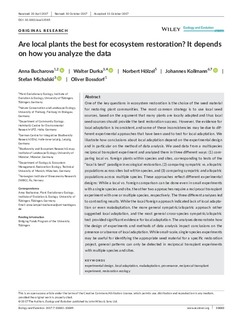| dc.description.abstract | One of the key questions in ecosystem restoration is the choice of the seed material for restoring plant communities. The most common strategy is to use local seed sources, based on the argument that many plants are locally adapted and thus local seed sources should provide the best restoration success. However, the evidence for local adaptation is inconsistent, and some of these inconsistencies may be due to dif- ferent experimental approaches that have been used to test for local adaptation. We illustrate how conclusions about local adaptation depend on the experimental design and in particular on the method of data analysis. We used data from a multispecies reciprocal transplant experiment and analyzed them in three different ways: (1) com- paring local vs. foreign plants within species and sites, corresponding to tests of the “local is best” paradigm in ecological restoration, (2) comparing sympatric vs. allopatric populations across sites but within species, and (3) comparing sympatric and allopatric populations across multiple species. These approaches reflect different experimental designs: While a local vs. foreign comparison can be done even in small experiments with a single species and site, the other two approaches require a reciprocal transplant experiment with one or multiple species, respectively. The three different analyses led to contrasting results. While the local/foreign approach indicated lack of local adapta - tion or even maladaptation, the more general sympatric/allopatric approach rather suggested local adaptation, and the most general cross- species sympatric/allopatric test provided significant evidence for local adaptation. The analyses demonstrate how the design of experiments and methods of data analysis impact conclusions on the presence or absence of local adaptation. While small- scale, single- species experiments may be useful for identifying the appropriate seed material for a specific restoration project, general patterns can only be detected in reciprocal transplant experiments with multiple species and sites. | nb_NO |

